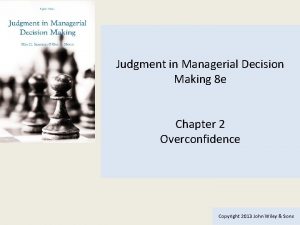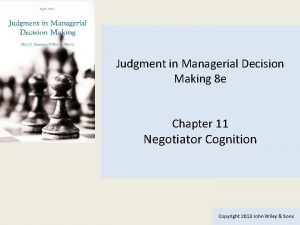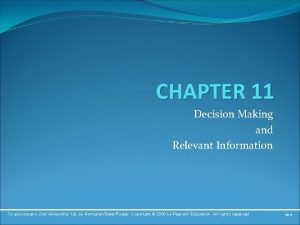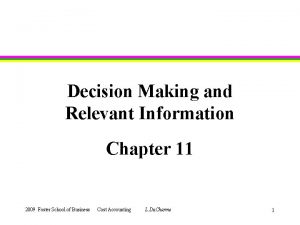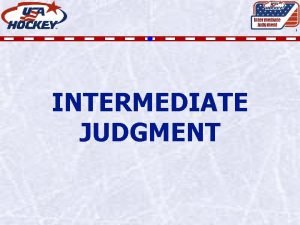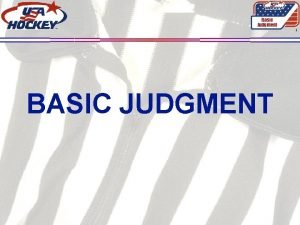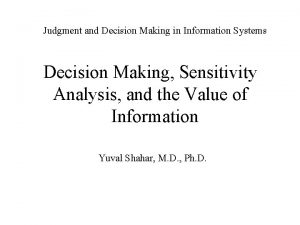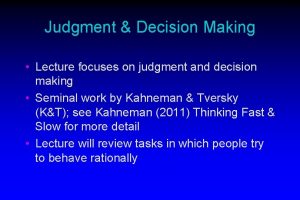Judgment and Decision Making in Information Systems Fallacies












- Slides: 12

Judgment and Decision Making in Information Systems Fallacies in Probability Judgment Yuval Shahar M. D. , Ph. D.

Probability Judgments • Both lay people and experts use various judgmental heuristics to judge the probability of uncertain events, such as: – Representativeness (similarity of an instance to a set) – Availability (ease of recall or generation of instances) – Anchoring and adjustment (starting from an initial value) • Probability judgment is mostly intuitive and, unlike formal probability models, is not extensional – It is not based on a detailed (possibly exhaustive) set of possible events – Compound probabilities are not aggregated from elementary ones

The Conjunction Fallacy in Probability Judgment (Tversky and Kahneman, 1983) • If the extension of event A includes the extension of event B, The probability of A should be equal or larger to that of B: – A B => P(A) P(B), because: – P(A) = P(A 1 A 2 … An) = P(A 1)+P(A 2)…+P(An), where each Ai is an extension (a possibility) of event A • Thus, the probability of a conjunction of events cannot be bigger than the probability of any of its components: P(A B) P(A) • In reality, people’s judgments of probabilities do not conform to this law, but are based on various heuristics

A Linguistic Conjunction Fallacy • • Given the probability estimation task: A. “In four pages of a novel (about 2000) words) how many words would you expect to find that have the form ----ing? ” § Options: (0, 1 -2, 3 -4, 5 -7, 8 -10, 11 -15, 16+) B. “How many words would you expect to find that have the form -----n-? ” The median estimates were: – A: 13. 4 (N = 52) – B: 4. 7 (N = 53), P<0. 01 Similar results for -----ly (median: 8. 8) versus -----l- (median: 4. 4) This obvious violation of the conjunction rule occurs due to increased availability (ease of retrievability) of *ing words versus *n- words

Representative Conjunctions • “Linda is 31 years old, single, outspoken and very bright. She majored in philosophy. As a student, she was deeply concerned with issues of discrimination and social justice and also participated in antinuclear demonstrations. • Rank the following 8 statements by likelihood: – – – Linda is a teacher in an elementary school Linda is active in the feminist movement (F) … Linda is a bank teller (T) … Linda is a bank teller active in the feminist movement” (T&F) • F>T&F>T, 85% (N=88)

Representative Conjunctions: Test Types • Indirect tests – Two different groups judge probability of conjunction and its constituents • Direct-subtle tests – Same subjects do both judgments but the inclusion relationship is not emphasized • Direct-transparent tests – Same subjects do both judgments in a format that highlights the inclusion relationship

Conjunction Experiments: Structure • Three types of subjects: – Statistically naïve undergarduates – Statistically informed graduates – Statistically sophisticated graduates • Two types of tests – Direct (subtle) – Indirect • Questions: About Linda and about Bill

Conjunction Experiments Results • In all comparisons, the conjunction is ranked higher than its constituents • There is no difference between direct and indirect tests! • Incidence of violations in direct tests is 88% overall • There is no effect of statistical sophistication level in either test type

Transparent Tests • The questions include only two alternatives: – Linda is a bank teller (T) – Linda is a bank teller and active in the feminist movement (T&F) • Nevertheless, 85% indicate that T&F>T (N=42) • Additional experiments strengthened the conclusions while showing that there is no misunderstanding of the statements

Other Representative Conjunction Experiments • Medical diagnosis – Expertise does not help in preventing the representational conjunction errors • Predicting Wimbeldon tennis results – Borg will lose the first set and win the match (2. 2 rank, where 1 is best) – Borg will lose the first set (2. 7) • Rolling a six-sided cube with 4 green and 2 red faces – GRGRRR ranked higher then RGRRR

Causal Conjunctions • Including a possible causal explanation elevates rated likelihood of a conjunction fallacy (58% in the following case): – Mr F had one or more heart attacks and is over 55 yrs old • Assigning the attributes to two different individuals reduced error rate to 29%

The Hot Hand Fallacy in Basketball (Tversky and Gilovich 1989) • People tend to see runs of hits and misses in basketball game – that is, P(Hit|previous hit)>P(Hit|previous miss) • In reality, neither analysis of a year of NBA games nor that of two college team games showed any statistical phenomena at any aggregation level: Basketball shooting is a pure chance process like coin tossing • The problem is due to the fact that people misperceive what random sequences really are, thus creating the cognitive illusion of finding patterns where none exist; and the more one watches games, the stronger the illusion!
 Judgement in managerial decision making
Judgement in managerial decision making Mythical fixed pie assumption
Mythical fixed pie assumption How do information systems aid in decision making
How do information systems aid in decision making No decision snap decision responsible decision
No decision snap decision responsible decision Slidetodoc.com
Slidetodoc.com Chapter 2 economic systems and decision making answer key
Chapter 2 economic systems and decision making answer key Chapter 2 economic systems and decision making
Chapter 2 economic systems and decision making Chapter 2 economic systems and decision making answer key
Chapter 2 economic systems and decision making answer key Decision making and relevant information
Decision making and relevant information Steps in decision making
Steps in decision making Decision making and relevant information
Decision making and relevant information Chapter 11 decision making and relevant information
Chapter 11 decision making and relevant information Decision making and relevant information
Decision making and relevant information
